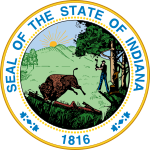| |||||||||||||||||||||
| |||||||||||||||||||||
| |||||||||||||||||||||
| Elections in Indiana |
|---|
 |
The 1831 Indiana gubernatorial election took place on August 1, 1831, under the provisions of the Constitution of Indiana. It was the sixth gubernatorial election in the State of Indiana. Noah Noble, a former state representative from Franklin County serving since 1830 as one of the commissioners of the Michigan Road, defeated state Representative James G. Read and outgoing Lieutenant Governor Milton Stapp. The election took place concurrently with races for lieutenant governor and members of the Indiana General Assembly.[1]
James B. Ray, the controversial incumbent governor, was term-limited and ineligible to run for a third consecutive mandate. Ray's popularity had declined precipitously following his narrow re-election in 1828. A contentious battle to shape the composition of the state supreme court made a permanent black mark on his reputation, as Ray was accused of arranging judicial nominations to promote his candidacy for the United States Senate. Much of his term was consumed by efforts to establish a state system of roads and canals. The centerpiece of this system was the Michigan Road running from Madison to Logansport. Over Ray's objections, the legislature named Noble a commissioner on the project to oversee awarding contracts for completion of the road in sections. By the end of 1830 all 163 miles of the road had been let to contractors at a total cost of over $62,000, making significant progress towards the opening of the road.[2]
Ray courted further controversy when he intervened in the case of four enslaved women of color brought into Indiana by their enslaver, William Sewell. Sewell was a Virginian traveling west when he was detained for several days in Indianapolis. Informed of their presence in a free state, the women left Sewell but were quickly retaken and brought before the circuit court on a writ of habeas corpus. Ray testified on the women's behalf, arguing that Sewell had forfeited all legal claim to his so-called property by traveling voluntarily to a free state. Judge Bethuel Morris concurred with Ray, ruling in favor of the women's freedom. Ray's testimony prompted severe rebuke from members of the state legislature. In 1831, the state adopted legislation to limit the migration of free people of color into Indiana, requiring that every African American resident post a $500 bond upon their arrival in the state and register with the local courts. Ray supported the legislation, wishing both to preserve Indiana's status as a free state and to forestall large-scale Black migration.[3]
As early as 1830, Noble and Stapp were mentioned as likely candidates to succeed Ray. As both men were outspoken Anti-Jacksonians, Jacksonians in the state sought to nominate their own candidate, eventually settling on Read. As in the previous election, the intrusion of national parties in state politics was a contentious issue. Internal improvements were a major issue in the campaign, as was slavery. Noble was criticized for using his office as contract commissioner for the Michigan Road to promote his campaign and for facilitating an illegal slave sale eleven years earlier. He nevertheless defeated Read by a narrow margin of 2,500 votes, with Stapp finishing a distant third.[4][5]
This was the last gubernatorial election before the introduction of formal party organizations in Indiana. While Read's candidacy originated with a gathering of Jacksonian lawmakers, both the candidates and affiliated newspapers denied the election was a partisan contest. Although Andrew Jackson had handily carried Indiana in the most recent presidential election and remained popular in the state, the outspokenly Anti-Jacksonian Noble defeated Read even despite a rival Anti-Jacksonian in the race. Historians Dorothy Riker and Gayle Thornbrough assign no party labels to the candidates.[6][7]
© MMXXIII Rich X Search. We shall prevail. All rights reserved. Rich X Search


